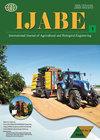养分管理中的可变施肥技术综述
IF 2.2
2区 农林科学
Q2 AGRICULTURAL ENGINEERING
International Journal of Agricultural and Biological Engineering
Pub Date : 2023-01-01
DOI:10.25165/j.ijabe.20231604.7671
引用次数: 1
摘要
对作物进行高效和有效的施肥是一项重大挑战。按惯例,每株植物施用等量或等量肥料。在整个田地中等量施肥会导致养分吸收过多或不足。施肥受土壤参数和田间地理变化的影响。养分管理取决于养分的选择、施肥量以及与作物的最佳距离和土壤深度。可变速率技术(VRT)是一种输入应用技术,它允许根据田地或植物的土壤性质和空间变化,以一定的速率、时间和地点施用输入。VRT的实现有两种方法,一种是基于传感器的,另一种是基于地图的。基于传感器的方法;通过合适的传感器,测量土壤和作物特性,计算每单位面积/植物所需的养分量,微控制单元使用合适的算法来控制所需养分量的肥料流动。在基于地图的方法;网格采样和土壤分析用于创建处方图。根据土壤和作物条件,单片机调节所需的施用量。基于传感器的VRT系统包括肥料罐、传感器、GPS、微控制器、执行器和其他组件,而基于地图的系统不需要移动传感器。本文综述了VRT在果园和大田作物施肥中的两种方法。这一先进技术的应用无疑提高了肥料的利用效率;在减少环境影响的同时提高作物产量和盈利能力。引用本文:Pawase P P, Nalawade S M, Bhanage G B, Walunj A A, Kadam P B, dulude A G, Patil M r。农业与生物工程学报,2023;16(4): 11-19。本文章由计算机程序翻译,如有差异,请以英文原文为准。
Variable rate fertilizer application technology for nutrient management: A review
The efficient and effective application of fertilizers to crops is a major challenge. Conventionally, constant rate or equal dose of fertilizer is applied to each plant. Constant rate fertilizer application across entire field can result in over or under incorporation of nutrients. Fertilizer application is influenced by soil parameters as well as geographical variation in the field. The nutrient management depends on selection of nutrient, application rate and placement of nutrient at the optimal distance from the crop and soil depth. Variable rate technology (VRT) is an input application technology that allows for the application of inputs at a certain rate, time, and place based on soil properties and spatial variation in the field or plants. There are two approaches for implementing VRT, one is sensor based and another is map based. The sensor based approach; with suitable sensors, measures the soil and crop characteristics on-the-go calculating the amount of nutrients required per unit area/plant and micro controlling unit which uses suitable algorithms for controlling the flow of fertilizer with required amount of nutrient. In map based approach; Grid sampling and soil analysis are used to create a prescription map. According to the soil and crop conditions, the microcontroller regulates the desired application rate. The sensor-based VRT system includes a fertilizer tank, sensors, GPS, microcontroller, actuators, and other components, whereas the map-based system does not require an on-the-go sensor. Both approaches of VRT for fertilizer application in orchards and field crops are reviewed in this paper. The use of this advance technology surely increases the fertilizer use efficiency; improve crop yield and profitability with reduced environment impacts. Keywords: nutrient sensor, prescription map, spatial variation, VRT Citation: Pawase P P, Nalawade S M, Bhanage G B, Walunj A A, Kadam P B, Durgude A G, Patil M R. Variable rate fertilizer application technology for nutrient management: A review. Int J Agric & Biol Eng, 2023; 16(4): 11-19.
求助全文
通过发布文献求助,成功后即可免费获取论文全文。
去求助
来源期刊

International Journal of Agricultural and Biological Engineering
AGRICULTURAL ENGINEERING-
CiteScore
4.30
自引率
12.50%
发文量
88
审稿时长
24 weeks
期刊介绍:
International Journal of Agricultural and Biological Engineering (IJABE, https://www.ijabe.org) is a peer reviewed open access international journal. IJABE, started in 2008, is a joint publication co-sponsored by US-based Association of Agricultural, Biological and Food Engineers (AOCABFE) and China-based Chinese Society of Agricultural Engineering (CSAE). The ISSN 1934-6344 and eISSN 1934-6352 numbers for both print and online IJABE have been registered in US. Now, Int. J. Agric. & Biol. Eng (IJABE) is published in both online and print version by Chinese Academy of Agricultural Engineering.
 求助内容:
求助内容: 应助结果提醒方式:
应助结果提醒方式:


